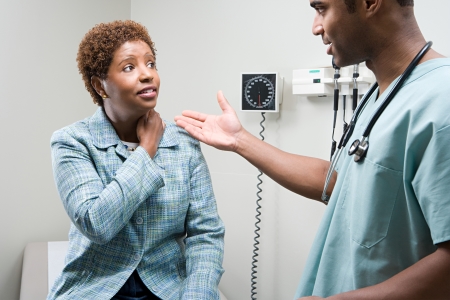Lung Infection has at least ten tell-tale warning signs and symptoms. Too often people shrug off lung infection symptoms.
They think their cough or fever is just a part of aging. Additionally, they might push themselves, thinking they are too busy to go to the doctor.
Such symptoms are not a part of normal aging. They are cries for help from your body.
The below symptoms are messages and warnings from your lungs and respiratory system. These symptoms tell you something is wrong. And they might indicate lung infection.
Thus, this article alerts you about the symptoms and signs of lung infection. Armed with such knowledge, you can be a proactive member of your own healthcare team.
Then, you will be aware of the messages sent by your body and you can control or cure the unpleasant symptoms with the help of your healthcare professional.
A Special Warning for Patients with COPD

Serious Symptoms Could Mean You Have a Lung Infection.
If the doctor has diagnosed you or someone you love with COPD, this list of symptoms is even more important. With COPD, “a lung infection may occur at some point.”
The reason is anatomical. You see, “The inflamed, narrowed airways and damaged air sacs characteristic of the condition makes one more prone to developing lung infections, particularly pneumonia.”
The following list of symptoms will help you identify your symptoms as serious. Hopefully, you won’t shrug off your body’s alerts before they become critical. Likewise, this article reveals ways to prevent lung infections from happening.
Factors Behind the Symptoms of Lung Infection
Keep aware that the following symptoms can vary. They can also be fairly mild to very severe. Also, understand the severity differs according to a range of factors in your life.
- Your doctor will consider your age.
- He or she will also check your overall health.
- Likewise, doctors will run tests to ascertain whether a virus, bacteria, or fungus is igniting your symptoms.
We understand that these symptoms also occur in common colds. However, in lung infection, the symptoms persist over a longer duration of time.
The FLASS Top Warning Symptoms of a Lung Infection
1. The Choking Cough
This symptom is not just a loose or dry cough. It is a cough that almost chokes you with thick mucus. “Coughing helps to rid your body of the mucus produced from inflammation of the airways and lungs. This mucus may also contain blood.”
In short, the darker the mucus, the more serious the infection. If you have bronchitis or pneumonia the thick mucus might be white, green, yellow-gray, or even brownish-black.
The “healthiest” mucus is clear. You should not tolerate choking for weeks before you call your doctor.
2. Fever: A Tell-Tale Warning to Consult Your Doctor
We know we get feverish when our body tries to fight off infection. However, did you know with a bacterial lung infection, it could rise to the danger zone of 105 degrees (40.5 C.) We don’t have to tell you how serious that would be.
With a high fever of 102 degrees (38.9C), symptoms multiply. You will have sweating, chilling, aching, weakness, and dehydration.
Fast Rule from FLASS: See your doctor if you register 102 degrees F. (38.9C) In fact, if your fever lasts 3 days, call the doctor. Your body needs help.
3. Sudden Sharp Pains in the Chest

Do Any Of These Symptoms Persist For Days? If so, Your Body is Calling Out For Help! See Your Physician.
Patients who suffer from lung infection describe their chest pain as sharp and stabbing. Of course, it feels worse with a cough or deep breaths. Likewise, you can feel these stabs in your mid to upper back.
4. The Perpetual Runny nose
Did you know that a runny nose and sneezing can quite often accompany a lung infection? It’s quite common in bronchitis.
5. About Your Aching Body
When you have a lung infection, you will feel aches in your muscles. We call this “myalgia.” Deep inflammation in your muscles can cause myalgia in your muscles.
6. High-Pitched Wheezing
If you hear a whistle when you exhale, it can be a serious symptom, not just a little harmless wheeze. Narrowed airways or inflammation cause that high whining whistle.
It’s a particularly good reason to see your doctor.
7. That Annoying Shortness of Breath
Let’s cover this lung infection symptom with three questions.
A. Do you think breathing is difficult?
B. Are you having trouble inhaling?
C. Can you take in a complete breath?
No ifs, ands, or buts! If you answered “yes,” to any of these questions, you need help. If you are having shortness of breath or trouble with breathing, see your healthcare professional.
It’s not normal. It’s not part of average aging. You should not put off taking action. Shortness of breath, also called dyspnea, could indicate a worsening lung infection.
8. Bluish Coloration in Your Skin or Lips
It’s common sense that lung infections deprive you of oxygen. We see this in bluish lips and nails.
Again, this is a serious symptom. Your body is sending you a warning it needs oxygen. Just, please call your doctor if you see this on you or your loved one.
9. Fatigue Beyond Exhaustion
Unusual weariness, weakness, and lethargy often accompany an infection. After all, your body is in constant fight mode. Therefore, resting is often a critical part of any prescription.
10. A Sure Warning of Lung Infection: Crackling or Rattling in the Lungs
This lung phenomenon is quite serious. Your doctor hears it through a stethoscope. It sounds like crackling in the base of the lungs.
We call these sounds “bibasilar crackles.” Although you might not be aware of them, these sounds typically indicate lung infections. And that is why you need to consult with your doctor.
A Quick Review of the Three Types of Lung Infections

Although a Lung Infection Can Be Serious, Proper Diagnosis and Care Can Bring You Full Recover.
Let’s take a quick look at the three major types of lung infections. With simple research, you can identify them as “Bronchitis, pneumonia, and bronchiolitis.” Typically, a virus or bacteria causes these types of lung infections.
Thus, you can learn that certain microorganisms cause bronchitis, and others cause pneumonia. Here’s the famous list so you’ll recognize them if your doctor mentions the tiny predators invading your body:
Viruses and Bacteria That Cause Bronchitis.
Many of you have heard of, and even endured the influenza virus or respiratory syncytial virus. (RSV) Likewise, bacteria such as Mycoplasma pneumoniae, Chlamydia pneumoniae, and Bordetella pertussis can cause bronchitis.
Mean Microorganisms Responsible for Pneumonia.
On the one hand, bacteria can cause pneumonia. Listen for such names as Streptococcus pneumonia (most common), Haemophilus influenza, and Mycoplasma pneumoniae.
On the other hand, viruses such as the influenza virus or RSV can instigate pneumonia.
- Sometimes fungi can cause lung infections. In this case, listen for names such as Pneumocystis jirovecii, Aspergillus, or Histoplasma capsulatum.
- Fungal lung infections are commonly discovered in people with immunosuppressed systems.
Common Sense: Reasons To Be Informed About Causes of Lung Infections
Why do we want you to know about the above three different causes of lung infections?
- One good reason is that antibiotics cannot cure a virus.
- For another reason, we don’t want you to take an old antibiotic prescription for similar symptoms.
Call the doctor for testing, so he or she can properly prescribe treatment for your new infection.
Terrific Take-Aways from Lung Infection Symptoms
Through reading this blog, we hope that you have learned that lung infections can be serious.
- You also probably discovered that lung infections and lesser illnesses have similar warning symptoms.
- Additionally, you should know that, as we age, the danger of lung infection can increase. Sadly, lung infections can cause death in older people.
- Thus, we advise you to warn loved ones these symptoms are serious. This is especially true when symptoms continue for weeks.
Lessons from the Pandemic
During the heyday of COVID-19, we learned great lessons about how to avoid infection. The lessons are the same for avoiding serious lung infections.
Cleaning your hands, not touching your face, and avoiding crowds, and sick people will also help you to avoid lung infections.
A Final Note of Warning

Reminder From FLASS Health Team: If You Are Over 65, Take Your Pneumonia Shot. It Could Save Your Life.
FLASS doctors and staff urge you to see your healthcare professional if you have a fever, piercing chest pain, and a phlegm-choked cough. Don’t shrug off these serious symptoms.
And remember, the above symptoms are especially critical warnings if you are already fighting COPD or another respiratory disease.

